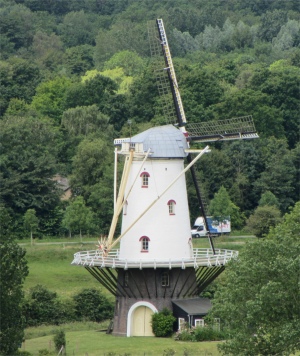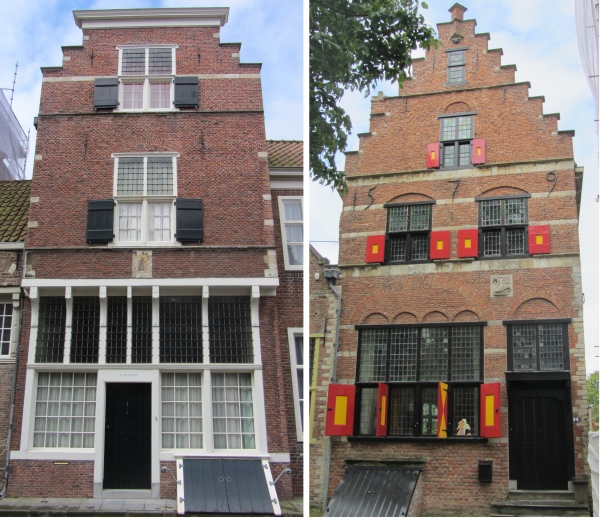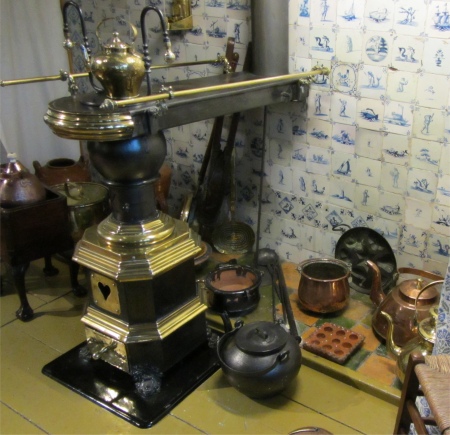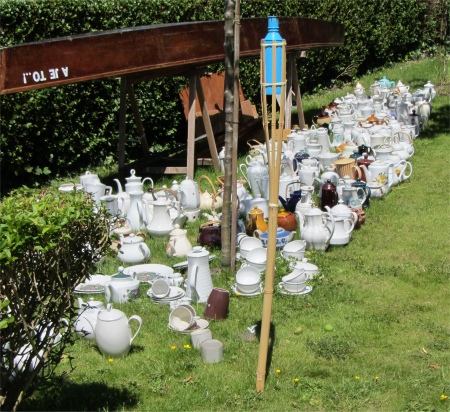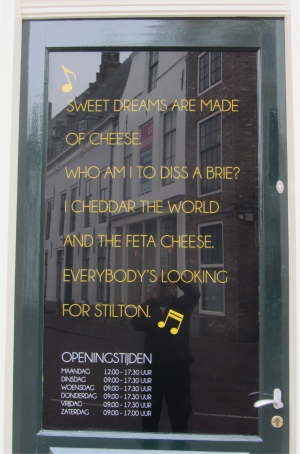 Middelburg Cheese Shop Door |
Soon we were on a bus to Veere, passing herds of sheep grazing on the grass verges by the road. In my original homeland, fell sheep graze by the narrow, winding, country roads. However, here they were by the main roads. I wondered what the road kill statistics were. I guess if anyone did strike a sheep, they could pick the carcass up and feed their family for a couple of months.
Like the buses in Kenya and Tanzania, this bus seemed to do umpteen detours around the suburbs of Middelburg, picking up passengers on the way, before striking out in the general direction of Veere. We coasted through lush, green farmland for the terribly long distance of 5km before we reached Veere. Yes, we could have walked there alongside the canal, but the drizzle and menacing skies made that an unattractive option. Besides, we would have missed the magical mystery tour.
The small city of Veere stood on the Veerse Meer lagoon. The name literally meant "ferry", perhaps stemming from 1281 when Wolfert Van Borsselen established a ferry there. Veere received city rights in 1355. On 8th January 1488, the "Admiraliteit van Veere" (Admiralty of Veere) was set up as a result of the Ordinance on the Admiralty in an attempt to create a central naval administration in the Burgundian Netherlands. The Vice-Admiralty of Flanders in Dunkirk was subordinated to this. In 1560 under Admiral Philip de Montmorency, Count of Hoorn, this admiralty relocated near Ghent and in 1561 the Habsburg naval forces were also moved to Veere. The city functioned as the staple port for Scotland between 1541 and 1799.
 Gardens Near the Markt |
Flemish architects Antonis Keldermans and Evert Spoorwater designed the Grote Kerk, the fortifications, the Cisterne and the town hall. Spoorwater was a visionary in a way, perfecting a method in which a detailed plan was made from which virtually all parts of a building could be manufactured at source, and upon delivery could be easily assembled with the aid of mortar. During this period of prosperity, the cultural centre was located at Sandenburgh castle, the residence of the noble Van Borsele and Van Bourgondië families. In the 17th and 18th centuries, Veere was a prosperous trading city, with about 750 houses inside the city walls then, compared to about 300 as of 2013. As a result of the damming of the Veerse Gat inlet in 1961, the fishing fleet of Veere moved to a new home port at Colijnsplaat on Noord-Beveland.
The bus terminus was on the edge of town, near the Grote Kerk. The latter did not open until later in the day, so we ambled into the town, passing little alleyways brimming with colourful hollyhocks. Grey skies had now given way to masses of cotton wool floating across an azure heavenly ocean; sun shines on the righteous. Beautiful gardens proliferated, and every house was an attraction in itself. Some houses on the Markt even had miniature version of classical palace gardens. The elongated square contained many authentic shops, several clothing stores and gift and souvenir, arts and crafts shops which kept Meryl absorbed for a while. It was all very twee, the perfect tourist trap, and we soaked it all up as tourists do; we were in the minority, overwhelmed by Dutch, Belgians and Germans.
 Side and Rear View of Campveerse Toren |
Most sites of interest didn't open until later in the day, so we killed some time with hot beverages in one of the tempting cafes in the Markt square. Rex was attentively listening out as he had been keen for me to hear the 48-bell carillon belonging to the elegant late Gothic Town Hall, which was erected in 1474. As I sipped an exquisite hot chocolate, he took pains to convince me of the ecstasies experienced when one listened to the cacophony of bells in action, each performance being of significant duration. Sadly he was to be disappointed, today there was an occasional clang as one of the workmen, who were refurbishing the town hall, bumped into one of the bells. Maybe another time.
 Town Hall Carillon Tower Being Refurbished |
On 25th May 1686, a major fire in the nave of the church raged. Started by careless plumbers, the entire roof of the church was destroyed, and a wooden tower structure in which bells were hung was also lost. Hmmmm.... careless plumbers indeed. When my niece flushed the toilet in her new-build house, she discovered to her horror that it had been plumbed into the hot water system! In more recent times, such as 1809, Napoleon's troops used the church as a military hospital. Later on it became a "house for beggars" and a barracks before going downhill and being used for storing timber. During the flood of 1953 it functioned as an emergency barn for rescued animals. Only during the 70s was the church restored as a cultural destination. Today, the once tall windows had been filled with bricks and replaced with much smaller windows on most of the edifice, probably due to the numerous incidents caused by the strong coastal wind. It possessed a truly varied history.
 Veere Grote Kerk |
To the south the Kanaal door Walcheren was represented as a silvery ribbon stretching in a straight line down to Middelburg, easily identified by Lange Jan. On the horizon squatted a collection of cranes and cavernous boatbuilding hangars - Vlissingen. Immediately below us charming townhouses cuddled up to each other in the narrow lanes, and the picturesque windmill, "Molen de Koe" (cow-mill), stoically stood just outside the town.
Back down into the church itself, a series of "sculptures" had been set up. To me, these were benches covered in sheep's wool, obviously conceptual art but totally lost on me. Two lady artists were precariously balanced on step-ladders creating a black papier-mâché hanging sculpture on a wire frame. What did interest me though was an excellent example of a Foucault Pendulum suspended from the ceiling of the building. The Foucault Pendulum is named after the French physicist, Jean Foucault, who first used it in 1851 to demonstrate the rotation of the earth. It was the first satisfactory demonstration of the earth's rotation using laboratory apparatus rather than astronomical observations. Mechanically, it's one of the simplest experiments possible: a heavy weight attached to a very long string or cable that is free to swing in any vertical plane. If you start a Foucault Pendulum swinging in one direction, after a few hours you will notice that it is swinging in a quite different direction without any outside input. Of course, it is not the plane of swing that is changing, it is actually the Earth which is rotating beneath it.



